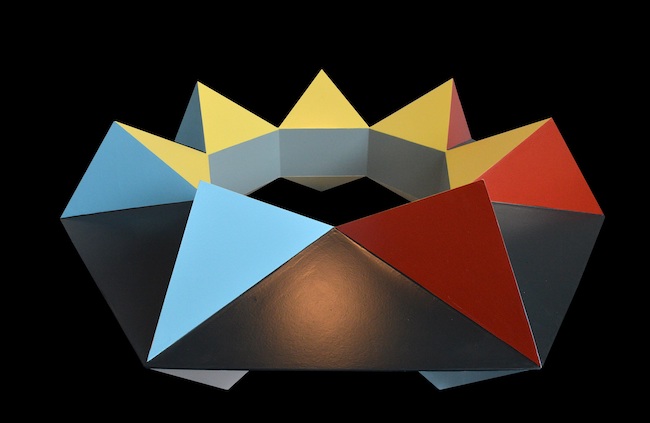L’approccio contemporaneo all’espressione artistica è impregnato di significati, di messaggi interpretativi sulla realtà contingente, sull’esistenzialismo e sulle inquietudini di una vita attuale che spesso destabilizza l’uomo come l’artista, che induce a perdere i riferimenti e a mettere in costante dubbio le conoscenze già acquisite e sovvertite da nuove certezze. Esiste però una categoria di artisti che sceglie di non andare a fondo della psiche o dell’interiorità, propria come dell’uomo moderno, bensì si sofferma sull’aspetto mentale e sperimentatore dell’intento creativo, alla scoperta di una bellezza data dallo studio della combinazione di forme e colori senza cercarne l’impatto emotivo pur risultando affascinanti agli occhi dei fruitori. Il protagonista di oggi appartiene a questa categoria di creativi.
Nel corso del primo ventennio del Novecento il distacco dall’arte precedente, con tutte le sue regole stilistiche, con il suo attaccamento alla figurazione e agli schemi esecutivi accademici e classici, fu prioritario per tutti i movimenti di quel periodo evolutivo intenso e vivace dopo il quale tutto si trasformò gettando le basi per le successive sperimentazioni e per le seguenti correnti che da quel momento in avanti continuarono a generarsi. In particolar modo il De Stijl, prendendo spunto dal Costruttivismo e dal Suprematismo russi pur modificandone le linee guida, mostrò al mondo non solo la necessità, bensì anche la possibilità che la manifestazione artistica potesse essere completamente distaccata da ogni figurazione conosciuta e da ogni moto emozionale pur restando la più alta forma espressiva, un incontro tra matematica e purezza del gesto plastico che non doveva necessitare l’aderenza all’osservato per generare una sublime creazione artistica. In opposizione alla concezione di Vasilij Kandinskij, in cui le figure geometriche potevano portare in sé un significato interiore, un intento emozionale, Theo Van Doesburg e Piet Mondrian affermarono invece con forza l’esigenza di una completa assenza di messaggio emozionale, di sensazioni, all’interno degli schemi matematici privi della terza dimensione e contraddistinti dall’uso di soli tre colori primari, il giallo, il rosso e il blu, accostati al bianco e al nero e dell’utilizzo di sole linee rette, che dovevano elevare il gesto plastico a forma creativa indiscutibilmente superiore.
Con la Scuola di Como e con quella sorta presso la galleria Il Milione di Milano, la rigidità delle linee rette e la limitazione all’uso di tre soli colori primari vennero superate dando così vita all’Astrattismo Geometrico che riuscì a raggiungere un pubblico più vasto e lasciare maggiore spazio di sperimentazione agli artisti aderenti alle sue linee guida i quali, superando la bidimensionalità, aprirono le porte anche all’interazione con la scultura, con il design e con l’architettura. Lo scultore tedesco Hans Adam aderisce all’Astrattismo Geometrico in maniera spontanea, avvertendo l’esigenza di lasciarsi andare alla sua naturale inclinazione che lo conduce a mescolare forme e colori che apparentemente non hanno senso, non se presi nella loro singolarità, ma che combinati tra loro generano invece affascinanti composizioni in cui lo sguardo dell’osservatore si perde proprio in virtù della mancanza di un messaggio emozionale, sentendosi attratto dall’approccio mentale che l’artista rivela.
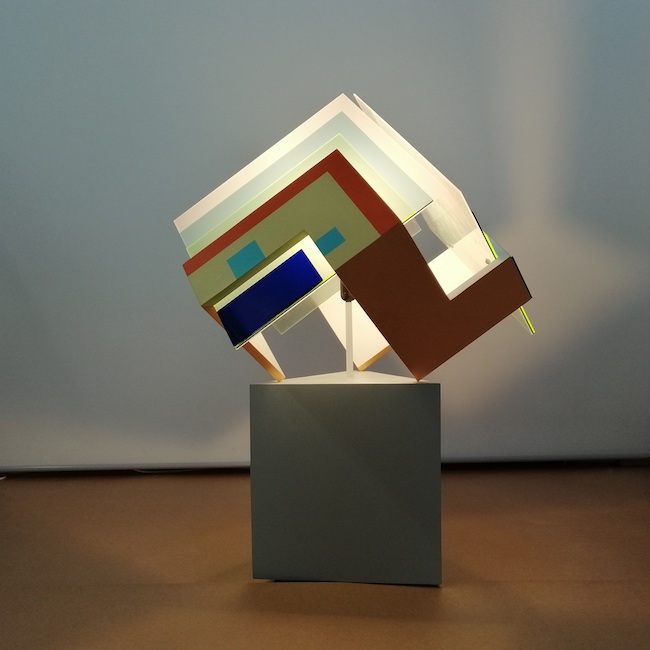
Il suo studio nasce dallo stimolo mentale, da quel desiderio di rappresentare senza raccontare, dall’escludere ogni significato e significante che non sia lo studio dell’interazione e la contiguità tra figure geometriche che si pongono in dialogo reciproco e che giungono ad assumere un senso completo solo quando la loro sinergia si compie.
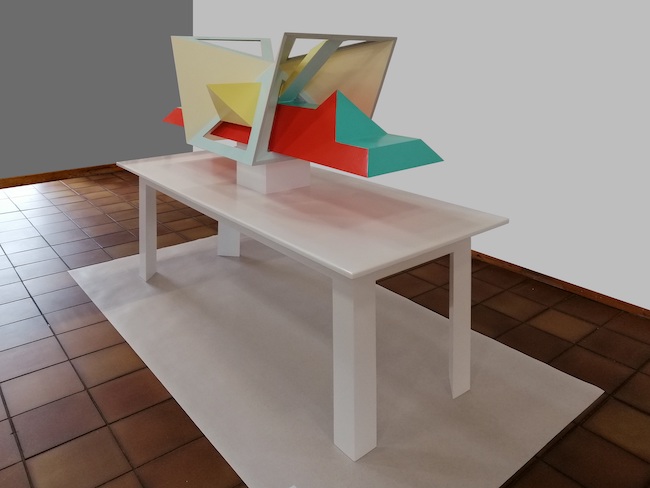
La gamma cromatica utilizzata da Adam è intensa, forte, volta a sottolineare e a scolpire le forme tanto quanto lo fanno i materiali scelti per dar vita alle sue sculture – betulla multistrato, legno, lacca, metallo, plexiglas, cornici, cartone -, che cercano la terza dimensione come interazione con l’ambiente circostante, come connessione e dialogo con lo spazio con cui la necessità di contatto sembra essere l’essenza stessa dell’intento creativo dell’artista.
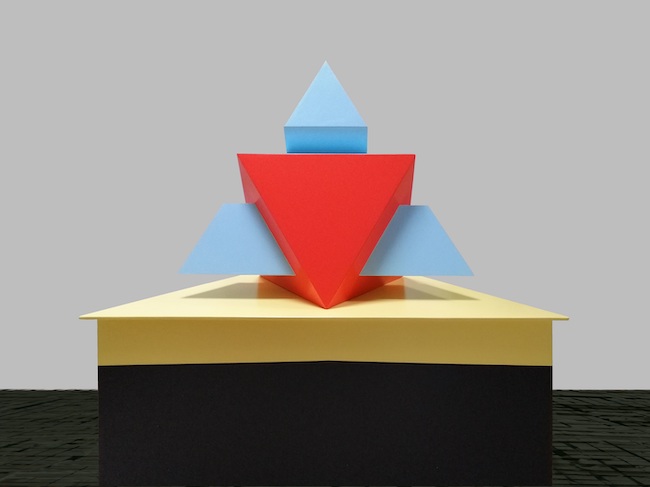
Nell’opera Zwei durch Eins (Da due a uno), Hans Adam esplora la trasformazione di una piramide rappresentata dal rosso in una semplificazione verso la bidimensionalità che contraddistingue con il celeste, come se il colore primario e pieno rappresentasse e sottolineasse la solidità della terza dimensione mentre la declinazione del blu, quella tonalità cielo con cui contraddistingue la riduzione, l’assottigliamento della consistenza, rappresentasse la leggerezza che la forma può assumere, la tendenza a occupare meno spazio e dunque divenire più immateriale, pur restando legata alla concretezza dell’esistenza.
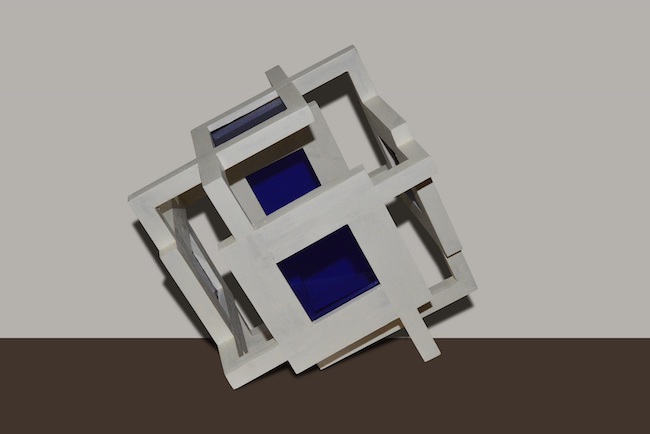
In Würfel mit Plexiglas (Cubo con plexiglas) Hans Adam evidenzia invece la leggerezza di una composizione in cui le linee geometriche mantengono la loro rigorosità ma entrano in connessione con lo spazio che non resta solo al loro esterno, non occupa solo l’area circostante la figura bensì penetra all’interno dell’opera in virtù dell’alternanza di vuoti e di pieni che l’artista sottolinea nella parte perimetrale del cubo. Il cuore della scultura è evidenziato in blu, manifestando così una tendenza cromatica più affine a quei colori primari tanto cara a Mondrian, pur mantenendo l’avvicendamento di spazi vuoti ad altri chiusi come a circoscrivere la possibilità di compenetrazione dell’area spaziale in cui la scultura è posta. Il plexiglas è funzionale a questo tipo di linguaggio espressivo per la sua caratteristica di leggerezza e di duttilità necessaria per infondere nella scultura il senso di leggerezza che ne fuoriesce.
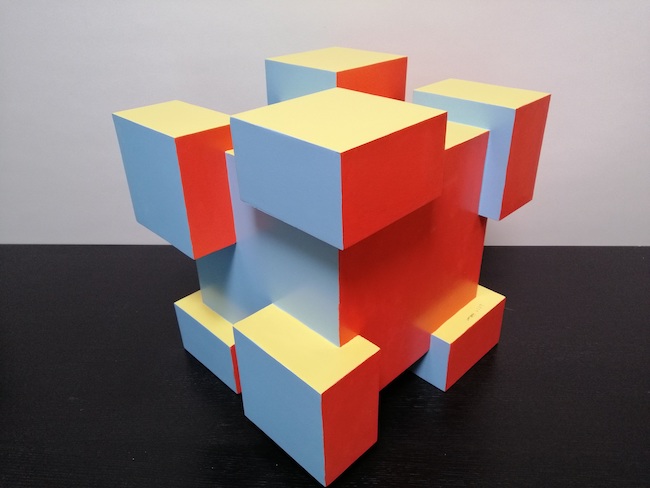
In Würfel und Kuben (Cubo e cubetti) al contrario, l’artista riempie lo spazio, creando una composizione in cui i pieni, i cubi appunto, si aggiungono alla figura solida e tridimensionale che è base della scultura, dando vita a dislivelli e gradini anch’essi in tre dimensioni, che vanno a invadere lo spazio circostante, dunque l’intento creativo è opposto all’opera precedente in cui Adam sembrava evocare l’apertura all’interazione, perché in questo caso sembra piuttosto verificarsi un’invasione, un tendere verso l’esterno, uno sperimentare l’occupazione delle superfici contigue all’opera. Nella composizione l’artista evidenzia i lati con colori differenti, il rosso, l’azzurro e il bianco, per dare un senso di continuità e di regolarità all’osservato in virtù di quell’attinenza alle regole prospettiche base ed essenza del suo approccio artistico.
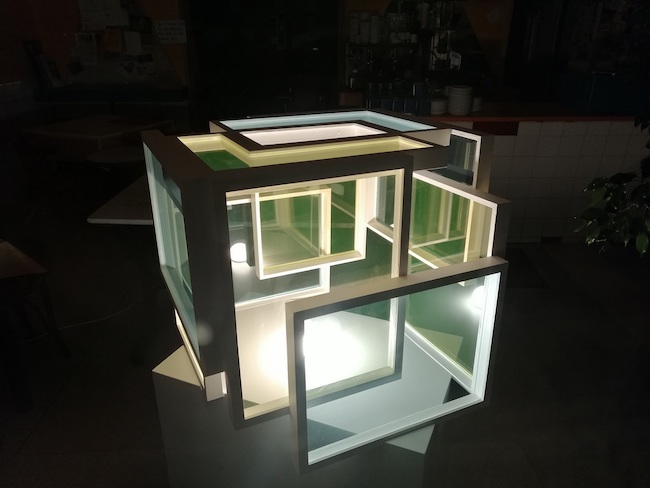
In Elf Bilderrahmen (Undici cornici) la ricerca scultorea di Hans Adam si sposta verso le realtà possibili di Escher, dove la prospettiva viene scardinata per mostrare opzioni che ingannano lo sguardo inducendo l’osservatore ad andare a scoprire il mistero che si cela dietro il visibile; qui è la profondità che gioca con l’occhio svelando, anziché nascondendo, i differenti punti di vista, le molteplici porte che si aprono nel momento in cui l’interconnessione tra volumi si palesa davanti all’osservatore. L’utilizzo dei led è necessario per generare l’ulteriore apertura verso una visione sfaccettata della realtà contingente.
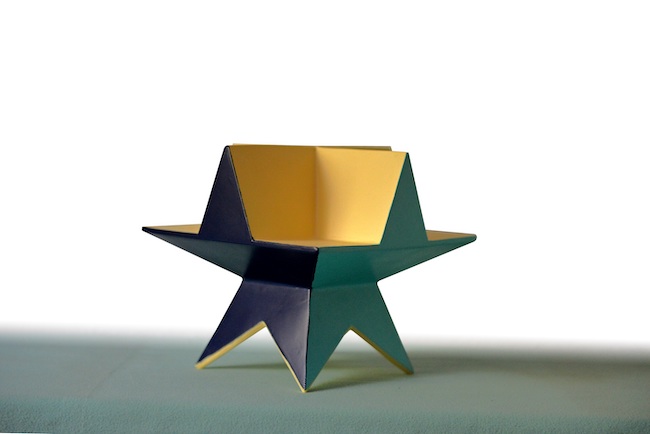
Malgrado nell’intenzione di Hans Adam l’opera d’arte non debba avere un significato emozionale, non può fare a meno di emergere, tuttavia, il parallelismo con la contemporaneità, con quell’esigenza di interconnessione, di apertura verso l’esterno inteso come altro da sé, tanto quanto di chiusura nel momento in cui la necessità è quella di proteggere l’interiorità, di empatia nei confronti di punti di vista molteplici tanto quanto lo è la personalità del singolo. Nel corso della sua lunga carriera artistica, iniziata nel 1996, Hans Adam ha partecipato a numerose mostre collettive su tutto il territorio tedesco riscuotendo successo tra il pubblico e tra gli addetti ai lavori.
HANS ADAM-CONTATTI
Email: hans_adam@gmx.de
Sito web: https://hansadam.de/
Facebook: https://www.facebook.com/hans.adam.92
Instagram: https://www.instagram.com/hansadam_24/
Experimentation in the meeting of geometric forms in Hans Adam’s sculptures
The contemporary approach to artistic expression is imbued with meanings, interpretative messages on contingent reality, on existentialism and on the anxieties of a current life that often destabilises man as well as the artist, inducing a loss of reference points and a constant questioning of knowledge already acquired and subverted by new certainties. There is, however, a category of artists who choose not to delve into the psyche or interiority of both themselves and modern man, but rather dwell on the mental and experimental aspect of their creative intent, discovering a beauty given by the study of the combination of shapes and colours without seeking emotional impact, even if they are fascinating to the eyes of the viewers. Today’s protagonist belongs to this category of creatives.
During the first twenty years of the twentieth century, the detachment from previous art, with all its stylistic rules, with its attachment to figuration and to academic and classical schemes of execution, was a priority for all the movements of that intense and lively evolutionary period after which everything was transformed, laying the foundations for subsequent experimentation and for the following currents that continued to be generated from that moment on. In particular, De Stijl, taking its cue from Russian Constructivism and Suprematism, although modifying their guidelines, showed the world not only the necessity, but also the possibility that artistic manifestation could be completely detached from every known figuration and every emotional movement while remaining the highest form of expression, an encounter between mathematics and purity of plastic gesture that did not need to adhere to the observed to generate a sublime artistic creation. In opposition to Vasilij Kandinskij’s conception, in which geometric figures could carry an inner meaning, an emotional intent, Theo Van Doesburg and Piet Mondrian instead strongly affirmed the need for a complete absence of emotional message, of sensations, Theo Van Doesburg and Piet Mondrian, on the other hand, strongly affirmed the need for a complete absence of inner message, of feelings, within mathematical schemes without the third dimension and distinguished by the use of only three primary colours, yellow, red and blue, juxtaposed with black and white, and the use of only straight lines, which were to elevate the plastic gesture to an unquestionably superior creative form.
With the Como School and the school that emerged at the Galleria Il Milione in Milan, the rigidity of straight lines and the limitation to the use of only three primary colours was overcome, giving rise to Geometric Abstractionism, which succeeded to reach a wider public and leave more room for experimentation for artists who adhere to its guidelines, which, by going beyond two-dimensionality, also opened the door to interaction with sculpture, design and architecture. The German sculptor Hans Adam adhered to Geometric Abstractionism spontaneously, feeling the need to let go of his natural inclination which led him to mix shapes and colours which apparently make no sense, not if taken in their singularity, but which when combined generate fascinating compositions in which the observer’s gaze is lost precisely because of the lack of an emotional message, feeling attracted by the mental approach the artist reveals. His study stems from the mental stimulus, from the desire to represent without telling, from the exclusion of all meaning and significance other than the study of the interaction and contiguity between geometric figures that engage in a reciprocal dialogue and only come to make complete sense when their synergy is fulfilled. The chromatic range used by Adam is intense, strong, aimed at emphasising and sculpting the forms as much as the materials chosen to give life to his sculptures – birch plywood, wood, lacquer, metal, Plexiglas, frames, cardboard -, which seek the third dimension as an interaction with the surrounding environment, as a connection and dialogue with the space with which the need for contact seems to be the very essence of the artist’s creative intent. In the artwork Zwei durch Eins (From Two to One), Hans Adam explores the transformation of a pyramid represented by the red into a simplification towards the two-dimensionality with which it distinguishes with the sky-blue, as if the primary, solid colour represented and emphasised the solidity of the third dimension while the declination of blue, the sky shade with which he distinguishes the reduction, the thinning of consistency, represents the lightness that form can assume, the tendency to occupy less space and thus become more immaterial, while remaining linked to the concreteness of existence.
In Würfel mit Plexiglas (Cube with Plexiglas), Hans Adam highlights the lightness of a composition in which the geometric lines maintain their rigorousness but enter into connection with the space that does not remain only outside them, does not occupy only the area surrounding the figure but penetrates inside the artwork by virtue of the alternation of empty and full spaces that the artist emphasises in the perimeter of the cube. The heart of the sculpture is highlighted in blue, thus manifesting a chromatic tendency more akin to those primary colours so dear to Mondrian, while maintaining the alternation of empty and closed spaces as if to circumscribe the possibility of interpenetration of the spatial area in which the sculpture is placed. Plexiglas is functional to this type of expressive language because of its characteristic lightness and ductility, which is necessary to infuse the sculpture with the sense of lightness that emerges from it. In Würfel und Kuben (Cube and Cubes), on the other hand, the artist fills the space, creating a composition in which the fulls, the cubes, are added to the solid, three-dimensional figure that forms the basis of the sculpture, creating differences in level and steps, also in three dimensions, which invade the surrounding space, The creative intent is therefore the opposite of the previous work in which Adam seemed to evoke an openness to interaction, because in this case there seems to be an invasion, an outward tendency, an experiment in occupying the surfaces adjacent to the work.
In the composition, the artist highlights the sides with different colours, red, blue and white, to give a sense of continuity and regularity to the viewer by virtue of that adherence to the basic rules of perspective and the essence of his artistic approach. In Elf Bilderrahmen (Eleven Frames) Hans Adam’s sculptural research moves towards Escher’s possible realities, where perspective is broken down to show options that deceive the eye, inducing the observer to go and discover the mystery behind the visible; here it is depth that plays with the eye, revealing rather than concealing the different points of view, the multiple doors that open up when the interconnection between volumes is revealed to the observer. The use of LEDs is necessary to generate a further opening towards a multifaceted vision of the contingent reality. Although in Hans Adam’s intention the work of art should not have an emotional meaning, the parallelism with contemporaneity cannot fail to emerge, with that need for interconnection, for openness to the outside understood as other than oneself, as much as for closure when the need is to protect the interiority, for empathy towards points of view as multiple as the personality of the individual. In the course of his long artistic career, which began in 1996, Hans Adam has taken part in numerous group exhibitions throughout Germany, and has been a great success with both the public and professionals.


